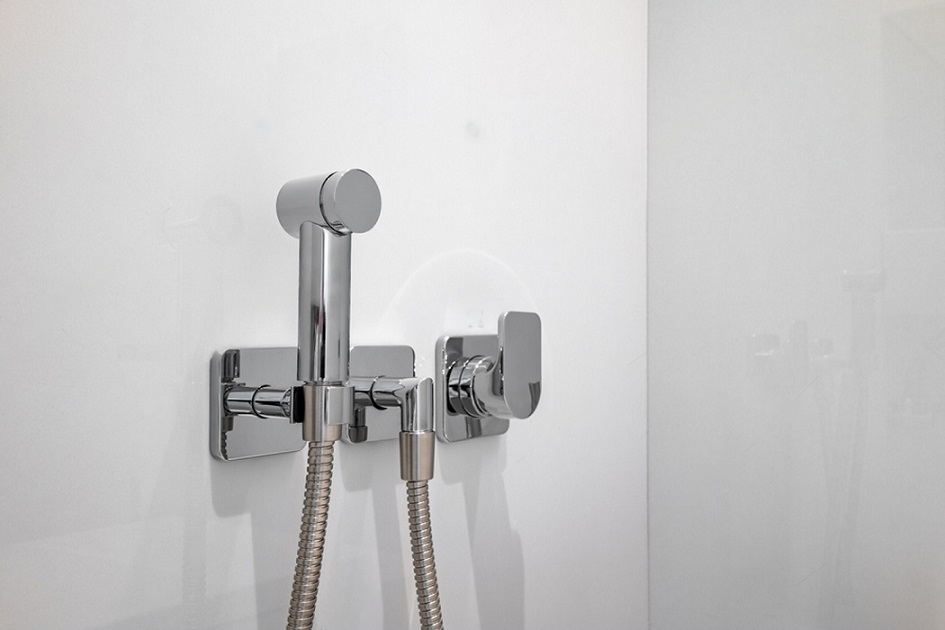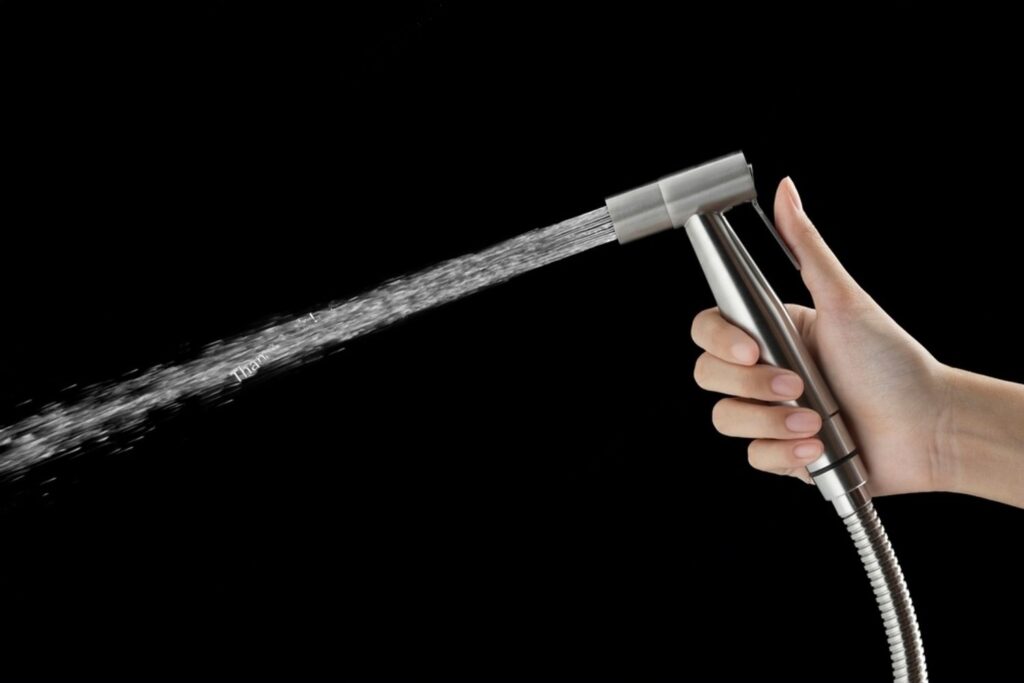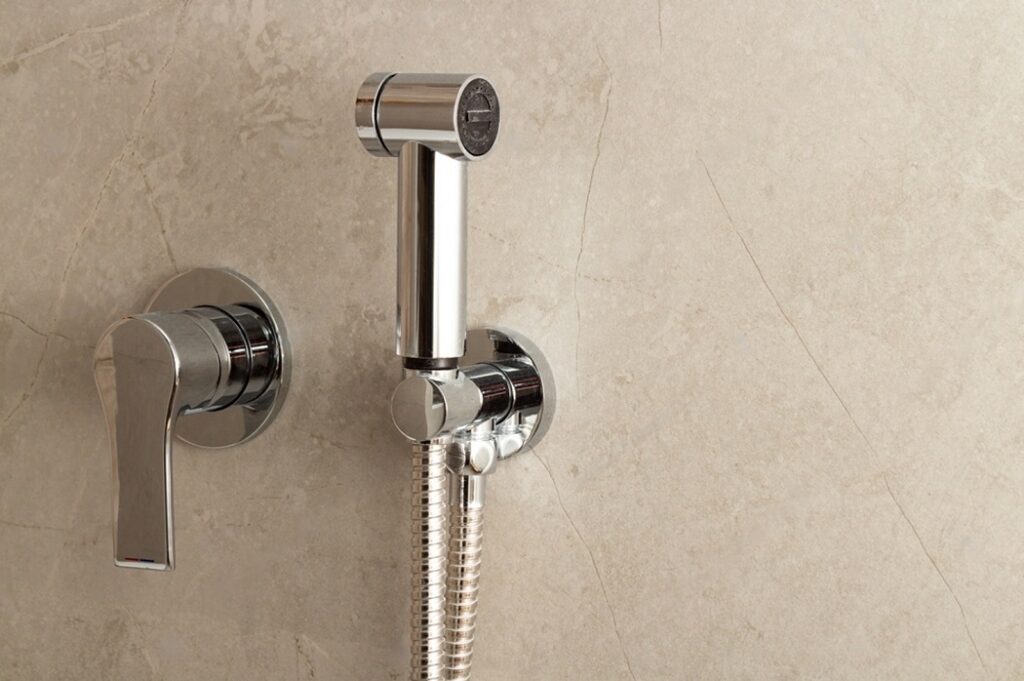Table of Contents
What is a Shattaf?

A Shattaf, also known as a Muslim shower or bidet spray, is a handheld tool used for personal hygiene in some parts of the world, particularly in Muslim-majority countries and regions with Islamic cultural influences. It is commonly found in bathrooms and toilets as an alternative to toilet paper for cleansing after using the toilet.
The Shattaf typically consists of a small, flexible hose with a nozzle at one end and a control valve at the other. The hose is connected to the water supply, and when the valve is opened, water flows through the nozzle, allowing the user to direct the water for cleaning purposes. The nozzle is designed to provide a gentle spray of water, which is used to clean the anal area after using the toilet.
The use of a Shattaf is considered more hygienic than using toilet paper alone and is believed to have originated from the Islamic tradition, which emphasizes the importance of cleanliness. However, it’s essential to note that practices and customs may vary among different cultures and individuals, and not everyone in regions where Shattafs are common necessarily uses them.
A bidet and a Shattaf serve similar purposes, which is to facilitate personal hygiene after using the toilet, but they are different in their design and usage:
Bidet:
- A bidet is a separate bathroom fixture that resembles a low, basin-like bowl or a small sink, usually located next to the toilet. It is a common fixture in many European countries and some other parts of the world.
- Bidets are designed for the user to sit on, facing the faucet. They are equipped with water jets that spray upward to clean the genital and anal areas.
- Some bidets may have additional features, such as adjustable water pressure, temperature control, and even air-drying functions.
- They are not handheld, so the user remains seated on the bidet during use.
Shattaf (Muslim Shower or Bidet Spray):
- The Shattaf is a handheld tool used for personal hygiene, especially in Muslim-majority countries and regions with Islamic cultural influences.
- It is a small, flexible hose with a nozzle at one end and a control valve at the other, typically attached to the wall near the toilet or as a separate fixture.
- The user holds the Shattaf and directs the water spray to clean the anal area after using the toilet.
- Shattafs are usually simple and do not have additional features like adjustable water pressure or temperature control.
In summary, the main difference between a bidet and a Shattaf lies in their design and installation. A bidet is a separate fixture with built-in water jets, while a Shattaf is a handheld hose with a nozzle that is operated by the user. Both are used for personal hygiene after using the toilet, but their usage and features can vary based on cultural practices and regional preferences.
What is Shatafa used for?

The term “Shatafa” appears to be another variation of the word “Shattaf”. To clarify, a Shattaf is a handheld tool used for personal hygiene, especially in some parts of the world with Islamic cultural influences. It is commonly found in bathrooms and toilets as an alternative to toilet paper for cleansing after using the toilet.
The Shattaf is a small, flexible hose with a nozzle at one end and a control valve at the other. It is typically attached to the wall near the toilet or as a separate fixture. When the valve is opened, water flows through the nozzle, allowing the user to direct the water for cleaning purposes. The nozzle is designed to provide a gentle spray of water, which is used to clean the anal area after using the toilet.
The use of a Shattaf is considered more hygienic than using toilet paper alone and is believed to have originated from the Islamic tradition, which emphasizes the importance of cleanliness. However, it’s important to note that practices and customs may vary among different cultures and individuals, and not everyone in regions where Shattafs are common necessarily uses them.
What is the Arabic name for Shattaf?
The Arabic name for Shattaf is “شطاف,” which is transliterated as “Shattaf” in English. The term “شطاف” is widely used in Arabic-speaking countries and regions, particularly in those with Islamic cultural influences, where the use of the Shattaf is common in bathrooms and toilets for personal hygiene purposes.
The word “شطاف” is derived from the Arabic root “ش-ط-ف” (sh-t-f), which generally conveys the notion of “cleaning” or “washing.” In the context of the Shattaf, it specifically refers to the cleaning process achieved by the handheld water spray.
The Shattaf, or شطاف, is an essential element of personal hygiene practices in these regions and is considered more hygienic than using toilet paper alone. The concept of using water for cleansing after using the toilet has deep cultural roots in the Islamic tradition, which emphasizes cleanliness and purity. As a result, the Shattaf is widely adopted and embraced as an integral part of daily personal hygiene routines in households, public restrooms, and other facilities.
Due to its popularity and widespread use, the term “شطاف” has become widely recognized and understood across the Arabic-speaking world. It is a symbol of cultural norms and practices that have been passed down through generations, reflecting the importance of cleanliness and ritual purity in Islamic customs.
In summary, “شطاف” or Shattaf in Arabic, is a handheld water spray used for personal hygiene after using the toilet, particularly prevalent in regions with Islamic cultural influences. Its name and function reflect cultural values related to cleanliness and ritual purity, making it an essential part of daily life in many Arabic-speaking communities.
How do you wash with Shatafa?

Washing with a Shattaf, also known as a Muslim shower or bidet spray, is a straightforward and hygienic process. It is commonly used in some parts of the world, particularly in Muslim-majority countries and regions with Islamic cultural influences. The Shattaf is a handheld tool that provides a gentle spray of water, offering an alternative to using toilet paper for personal hygiene after using the toilet.
Here is a step-by-step guide on how to wash with a Shattaf:
Preparation:
- Before using the Shattaf, ensure that the water supply is connected and the control valve is functioning correctly.
- The Shattaf is usually hung on the wall near the toilet or placed in a holder within easy reach.
Finish using the toilet:
- After completing your bowel movement, follow your usual wiping routine using toilet paper. The Shattaf is meant to complement, not replace, the initial wiping.
Positioning:
- Once you have wiped with toilet paper, assume a comfortable position on the toilet seat. The exact position may vary based on personal preference and mobility, but it typically involves facing towards the toilet.
Activating the Shattaf:
- Hold the Shattaf handle firmly with your dominant hand, and using your other hand, turn on the control valve to allow water to flow through the nozzle.
- Be cautious with the water pressure to avoid discomfort, starting with a gentle flow and adjusting as needed.
Cleansing:
- Direct the nozzle towards the anal area, ensuring that the water spray is focused on the area that requires cleaning.
- Move the nozzle gently back and forth or in a circular motion to ensure thorough cleansing.
- The Shattaf allows you to control the water flow and direction, making it easy to achieve the desired level of cleanliness.
Adjusting the water temperature (optional):
- Depending on the Shattaf model and installation, some may have temperature control options. If available, you can adjust the water temperature to your preference before using it.
Drying (optional):
- After washing, some people prefer to pat dry with a small towel or use a bidet with an air-drying function, if available.
- Others may choose to allow themselves to air dry naturally.
Turning off the Shattaf:
- Once you are done using the Shattaf, turn off the control valve to stop the water flow.
Post-cleansing:
- After washing with the Shattaf, you can use a small amount of toilet paper or a towel to ensure that you are dry and clean.
Cleaning the Shattaf (if required):
- Some Shattafs have a self-cleaning function, but if not, make sure to clean the nozzle periodically to prevent any build-up of residue or bacteria.
It’s important to remember that practices and customs can vary among different cultures and individuals. While the use of a Shattaf is common in some regions, others may prefer different methods of personal hygiene after using the toilet. The main aim is to maintain cleanliness and personal comfort while respecting individual preferences and cultural practices.
Do all Arabs use bidets?
No, not all Arabs use bidets. The use of bidets, or any similar hygiene tools like Shattafs (Muslim showers or bidet sprays), varies among individuals and cultures, even within Arab countries. The adoption of bidets is influenced by factors such as personal preferences, cultural traditions, economic factors, and access to modern bathroom fixtures.
In many Arab countries and regions with Islamic cultural influences, bidets and Shattafs are relatively common, and some households may have them as standard fixtures in their bathrooms. The Islamic tradition emphasizes the importance of cleanliness, which contributes to the popularity of bidets and Shattafs as they provide a more thorough cleaning option compared to using toilet paper alone.
However, it’s essential to recognize that practices and habits can differ widely among individuals and communities. Not everyone in Arab countries uses bidets or Shattafs, and many people may still prefer to use traditional methods or rely solely on toilet paper for personal hygiene.
As with any cultural practice, it’s essential to be respectful of individual choices and recognize that personal hygiene habits can vary based on a range of factors, including personal beliefs, customs, and access to different bathroom facilities.
What do Arabs call a bidet?

In Arabic, a bidet is commonly referred to as “مغسلة” (pronounced: maghsalah) or “بيديه” (pronounced: beedeeh). Both terms are used to describe the same bathroom fixture that facilitates personal hygiene after using the toilet.
- مغسلة (Maghsalah):
- The word “مغسلة” directly translates to “washbasin” or “washing place” in English.
- In the context of a bidet, it specifically refers to the basin-like fixture designed for personal cleansing after using the toilet.
- The term “مغسلة” is widely used in various Arab countries, and it is easily understood when discussing bathroom fixtures and personal hygiene practices.
- 2. بيديه (Beedeeh):
- The word “بيديه” is a borrowed term from the French word “bidet,” and it is commonly used in some Arab countries to refer to a bidet.
- This term is particularly prevalent in regions with historical French influence or due to the French colonial past in some Arab-speaking countries.
- While “مغسلة” is a more traditional Arabic term, “بيديه” is used in informal settings and often when referring to bidets in modern contexts.
It’s essential to note that the usage of these terms may vary slightly depending on the specific dialects and regional variations within the Arab world. However, both “مغسلة” and “بيديه” are generally understood and recognized as names for the bathroom fixture used for personal cleansing purposes after using the toilet.
In Arab culture, bidets, or “مغسلة” / “بيديه,” are valued for their hygienic benefits and are commonly found in bathrooms alongside toilets. They are used to cleanse and freshen up after using the toilet, promoting a sense of cleanliness and comfort. This practice aligns with Islamic teachings, which emphasize the importance of cleanliness and purification in daily life, including personal hygiene rituals.
